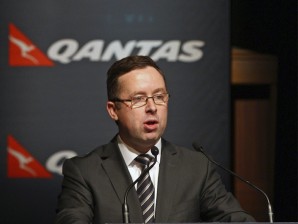
Qantas CEO Alan Joyce discusses the airline’s full-year financial results in Sydney, Thursday, Aug. 23, 2012. Qantas Airways Ltd. reported a 245 million Australian dollar ($257 million) annual loss in profits on Thursday, hurt by rising fuel prices, a series of strikes that temporarily grounded its fleet and its struggling international division. (AP Photo/Rick Rycroft)
SYDNEY — Qantas Airways Ltd. reported a 245 million Australian dollar ($257 million) annual loss in profits on Thursday, hurt by rising fuel prices, a series of strikes that temporarily grounded its fleet and its struggling international division.
The Australian flagship carrier’s net loss for the 12 months through June 30 compares with a profit of AU$250 million last year.
It was the first time since Qantas — nicknamed the “Flying Kangaroo” — went private in 1995 that the airline reported a net loss. After posting the result, CEO Alan Joyce said Qantas would be canceling its order for a new fleet of 35 Boeing 787-9 aircraft, worth $8.5 billion at list prices. It is still planning to buy 15 787-8s.
“The B787 is an excellent aircraft and remains an important part of our future. However, circumstances have changed significantly since our order several years ago,” Joyce said in a statement. “It is vital that we allocate capital carefully across all parts of the Group.”
Qantas blamed the annual loss on its AU$4.3 billion fuel bill — up 18 percent from last year — an industrial dispute that the airline said cost AU$194 million, and its international business, which lost AU$450 million and is struggling amid increased competition.
“Our biggest challenge is Qantas International, but its transformation is on track,” Joyce told reporters. “Our goal is to return it to profit and ensure it remains Australia’s iconic flagship carrier.”
Qantas said underlying profit before tax — the airline’s preferred measure of financial performance — was AU$95 million, a steep drop from AU$552 million a year ago.
Joyce declined to offer profit guidance for next year, saying it would be “imprudent” given the uncertain global conditions.
The airline had warned in June that it expected a drop of up to 91 percent in full-year earnings, which immediately sent the company’s stock plummeting to all-time lows. By late Thursday morning, however, shares were up 3.4 percent to AU$1.21 on the Australian stock exchange.